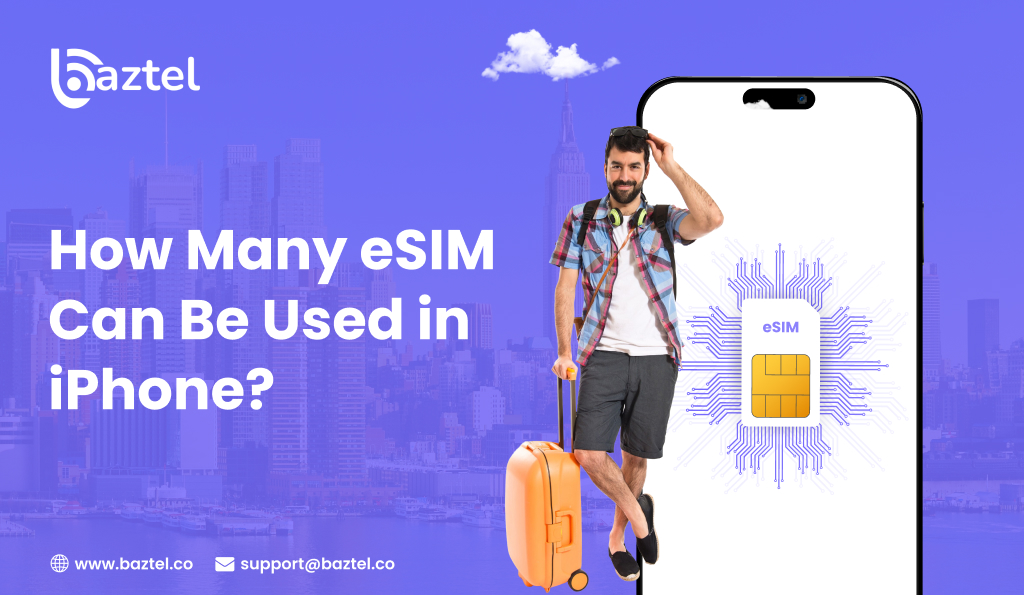eSIM isn’t a future thing anymore. It’s already here. And in 2025, it’s growing faster than ever, especially in some countries more than others.
If you travel often or follow tech trends, you might have noticed how easy it’s become to get mobile data without a SIM slot. No need to visit a store or hunt for a kiosk at the airport. You just scan a code and it works.
But here’s the catch. Not every country is moving at the same pace. Some have full eSIM support, while others are still figuring it out.
In this blog, we’ll break down eSIM adoption by country, show where it’s growing fastest in 2025, and help you see which countries are ready and which are still catching up.
If you want a full picture of how eSIM is changing global travel and connectivity, you can also check out our Future of eSIM blog.
What Drives eSIM Adoption in 2025?
Every country has a different story when it comes to eSIM. Some are way ahead, some are just getting started. But there’s always a reason behind the speed.
The first big reason is mobile operators. If local telecom companies support eSIM and offer good plans, adoption picks up fast. In countries like Germany and the USA, people already have 5–6 plan options from major networks all eSIM ready.
Second, phone brands matter. If most people use eSIM-ready devices (like iPhones or Pixel phones), switching becomes easier. That’s why places like Japan and South Korea are growing fast. Users already have the tech in hand.
Government rules also play a role. Some countries push eSIM aggressively to support digital travel, reduce plastic, or control SIM fraud. Others are slower due to old infrastructure or complex regulations.
And let’s not forget awareness. Many people still don’t know what eSIM is. Even if it’s available, they continue using physical SIMs out of habit. As per GSMA Intelligence, we’ll have nearly 850 million eSIM connections by 2025, with 76% of phones expected to support eSIM by 2030.
eSIM Countries List 2025 – Where It’s Already Working
Let’s get practical. You want to know where eSIM actually works today? Not just hype.
First up, India. Operators like Jio, Airtel, and Vi offer eSIM on postpaid plans and even BSNL does in parts of Tamil Nadu. That means if you’re in the big cities, you can activate instantly without stepping into a store.
Nearby, Singapore shows how far eSIM has come. All big operators Singtel, StarHub, M1, SIMBA support eSIM and it’s not niche anymore. For travelers, that’s smooth connectivity.
Let’s step up a bit. The USA isn’t just talking about eSIM it’s a leader. According to GSMA, by 2024, about 25% of global eSIM smartphone connections will come from the US. That’s real traction.
On the other hand, China is right behind. Amra & Elma forecast China will hit 500 million eSIM smartphone connections by 2025. That alone could make it the biggest eSIM market in the world.
Fastest Growing eSIM Markets in 2025
Some countries are not just using eSIM. They’re doubling down on it.
Let’s start with Germany. It already had strong support from carriers like Deutsche Telekom and Vodafone. But now even regional operators are pushing eSIM on both prepaid and postpaid plans. That’s pushing adoption across all age groups, not just techies.
Then comes South Korea. People there upgrade phones often. Brands like Samsung, Apple, and LG dominate the market and all support eSIM. This makes it easier for users to switch data plans without changing SIMs.
Japan wasn’t that fast initially. But since Apple pushed eSIM-only models in the US, Japanese telecoms started offering better support especially for travelers and students.
Brazil is also moving fast. With increasing smartphone penetration and local awareness campaigns, more users are switching. Even some government apps now promote eSIM for digital security.
eSIM Availability in 2025 – What Travelers Need to Know
Traveling is different now. You don’t need to search for a SIM card at the airport or carry a backup just in case. If the country supports eSIM, you can scan a code before your flight and go online as soon as you land.
But here’s the tricky part: eSIM availability in 2025 still depends on the country you’re visiting.
Let’s say you’re flying to Ireland. You can buy your eSIM online, activate it from home, and skip kiosk queues. Same goes for Canada, where most major networks support instant activation.
But if you’re going to places like Nepal or Pakistan, support may be limited. You might still need to do manual activation or visit a local office.
This is why travelers are now checking eSIM coverage before booking flights. It’s become a basic checklist item just like a passport and visa.
Want to know if your phone works with an eSIM?
We’ve covered it here: Is My Phone eSIM Compatible?
And if you’re heading abroad soon, check out our international eSIM plans sorted country-wise.
Countries Still Behind in eSIM Readiness
eSIM is growing but it’s not everywhere yet. Some countries are still stuck in the early phase. Either the carriers don’t support it, or the rules make it hard to roll out.
Take Pakistan. Some telecoms have tested eSIM, but it’s mostly for postpaid users. Prepaid eSIM is rare. Tourists usually go for physical SIMs because they’re easier to get.
Nepal also faces similar issues. Even if your device supports eSIM, you may need to visit a telecom store in person. And sometimes, activation takes longer than expected.
In some African countries, eSIM is still in pilot mode. Mozambique, Sudan, and Chad have very limited eSIM access either due to lack of infrastructure or security-related restrictions.
What’s slowing them down?
- Low awareness: Most people haven’t even heard of eSIM.
- Old networks: Some carriers still run on legacy systems.
- Manual setup: In many places, QR code activation doesn’t work. Users need help from a store.
According to MobiliseGlobal, awareness in countries like Australia, France, and South Africa is still under 15%. That shows how far we still have to go.
So, while eSIM adoption by country is improving, it’s still uneven.
How Will the eSIM Landscape Change by 2030?
If 2025 is about eSIM growth, 2030 might be when eSIM becomes the default. No trays. No plastic. Just digital connectivity built into the phone.
Right now, some phones still give you both physical and eSIM. But that’s changing fast. Apple already dropped the SIM tray in some US models. Other brands are expected to follow.
Countries like China, USA, South Korea, and Germany are expected to lead the shift. They have the networks, the phones, and the user base to make it happen.
But this isn’t just about phones. eSIM will spread to smartwatches, wearables, connected cars, and IoT devices. That’s where the real scale comes in.
According to Future Market Insights, the eSIM subscription market will grow from $2.2 billion in 2025 to nearly $30 billion by 2035 with smart devices leading the charge.
So if you’re planning long-term whether you’re a traveler, a business, or just someone who wants fewer wires and fewer hassles now’s the time to understand how fast things are shifting.
eSIM isn’t replacing physical SIMs someday. It’s already happening. And by 2030, eSIM availability 2025 will feel like the slow beginning.
Conclusion
eSIM is no longer just an option. It’s becoming the standard especially in countries that are moving fast with tech upgrades, telecom support, and travel needs.
But the pace isn’t the same everywhere. Some regions have embraced eSIM fully. Others are still catching up. That’s why understanding eSIM adoption by country helps whether you’re planning a trip, launching an app, or just buying your next phone.
If you want to dig deeper into how eSIM is shaping the future of mobile connectivity, head over to our Future of eSIM blog.
And if you’re planning a trip, explore our international eSIM plans sorted country-wise and ready to activate.
FAQs
Which countries will support eSIM in 2025?
Most countries in Europe, North America, and parts of Asia fully support eSIM.
Places like the USA, Germany, Japan, China, and India offer strong network-level support through top telecoms.
But smaller countries may still have limited options.
You can check our eSIM countries list to see what’s available before your trip.
Is eSIM available for prepaid users in every country?
No. Some countries still offer eSIM only on postpaid plans, especially in Asia and Africa.
In places like Pakistan or Nepal, prepaid eSIM is rare or requires manual setup.
How can I check if my phone supports eSIM?
Most newer phones like iPhones (XR and above), Pixel phones, and Samsung Galaxy S series support eSIM.
You can check our full eSIM compatibility guide to be sure.
Is eSIM better than physical SIM for international travel?
Yes, especially in 2025. With eSIM, you don’t need to find a shop or swap cards.
Just buy online, scan the QR code, and go online when you land.
If you’re heading to Canada or Ireland, eSIM is the easiest option.
Which countries are slow in eSIM adoption?
Some countries are still catching up due to regulations or poor awareness.
Examples include Sudan, Chad, Nepal, and a few parts of Latin America.
Even in some developed countries, people still prefer physical SIMs out of habit.
Blog Author
Peter
Peter started BazTel.co to make mobile internet easier for travellers. He noticed how tough it was to find good network options while visiting new countries. That’s when he built BazTel — a place where anyone can buy eSIMs online without confusion or long steps. He believes tech should be simple and useful, not complicated. When he’s free, he likes to travel, test BazTel himself, and keep improving it based on real user problems.

 Botswana
Botswana Zambia
Zambia Congo
Congo Colombia
Colombia China mainland
China mainland Chile
Chile Chad
Chad Central African Republic
Central African Republic Canada
Canada Cameroon
Cameroon Cambodia
Cambodia Burkina Faso
Burkina Faso Bulgaria
Bulgaria Brunei Darussalam
Brunei Darussalam Brazil
Brazil Aland Islands
Aland Islands Bosnia and Herzegovina
Bosnia and Herzegovina Bolivia
Bolivia Belgium
Belgium Belarus
Belarus Bangladesh
Bangladesh Bahrain
Bahrain Azerbaijan
Azerbaijan Austria
Austria Australia
Australia Armenia
Armenia Argentina
Argentina Algeria
Algeria



